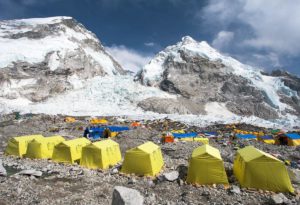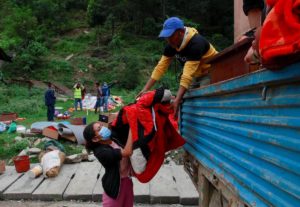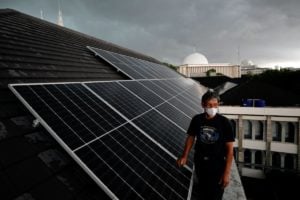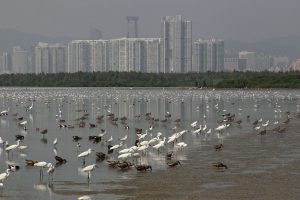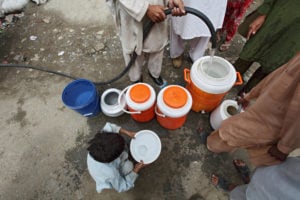In March 2018, an environmental impact assessment (EIA) for a proposed airport in Nijgadh, in southern Nepal’s Bara district, was submitted to the Ministry of Forests and Environment. By May, the environment ministry had approved the report – from a private firm hired by the Civil Aviation Authority of Nepal – opening the door for the authority to move ahead with the USD 3.5 billion project. This despite the fact that constructing the airport would mean clearing 2.4 million trees in of one of Nepal’s last remaining subtropical forests.
The report was approved “in haste”, an official at the environment ministry, speaking on condition of anonymity, told The Third Pole. “There was not much time to review a huge technical document of such a big project in a short period of time,” the official said, citing pressure from the Ministry of Culture, Tourism and Civil Aviation.
The report contained errors. Chapter eight of the report, which is not yet publicly available but has been seen by The Third Pole, refers to electricity generated from the project: the sentence was mistakenly copied and pasted from another report for a hydropower project. The report did not, as EIAs are supposed to, present comparative analyses of different potential sites – it simply stated the forest area as the best choice.
Media reports of flaws in the EIA stirred protests over the government’s decision to approve it, with the case eventually ending up in Nepal’s supreme court. After three years, in May 2022, the court directed the government to halt the project in Nijgadh and restart the EIA process from scratch.
The Nijagh airport saga serves as an example of Nepal’s troubles with EIAs. While environmental assessments are being conducted for projects across the country, converting this process into meaningful reduction of environmental harm is proving challenging.
EIAs in Nepal
Ever since the 1960s, when they were introduced in the United States, environmental impact assessments (EIAs) have become a well-recognised tool to mitigate the environmental impacts of large infrastructure projects across the globe.
Nepal started to use EIAs in 1997, after enacting the Environment Protection Act. The law obliged any company or government body planning an infrastructure project to conduct environmental assessments. Large projects require a full environmental impact assessment (EIA), whereas smaller ones require an initial environmental examination (IEE). Nepalese law allows for developers to be prosecuted if they do not follow mitigation measures laid out in the approved EIA or IEE.
EIAs are detailed reports prepared by project developers before construction starts. They assess what environmental impacts will likely result from implementation of the project, and whether these impacts could be reduced or mitigated by any means.
IEEs are also analytical reports conducted prior to construction, which assess the project’s environmental impacts and whether impacts could be mitigated. IEEs are less detailed than EIAs and are required for smaller projects.
Nepal’s Environment Protection Rules 2020 (2077) lists projects that need IEEs under Schedule 2, and those that need EIAs under Schedule 3.
EIAs must be submitted to Nepal’s Ministry of Forests and Environment (MoFE) for approval, whereas IEEs can be approved by other relevant ministries. For example, an EIA for a major highway would need approval from the MoFE, whereas the Department of Roads can approve an IEE for a shorter road project (up to 25km). Similarly, a hydropower project up to 50MW in capacity requires an IEE, while projects above 50MW need a full EIA.
“So far, EIAs in Nepal have been of a low standard, and have failed to serve their purpose in mitigating environmental problems and protecting communities,” Madhu Ghimire, head of the EIA section at the Ministry of Forests and Environment (MoFE), tells The Third Pole. The MoFE is responsible for reviewing and approving EIAs.
“[EIAs] have been taken by developers as just a procedural step before implementing any project, rather than a tool to mitigate environmental impacts and safeguard investments,” she says. Asked why flawed reports, such as the EIA for the Nijgadh airport, are still approved, she said developers refuse to do more work on reports once they’re submitted. “If we ask developers to review and rework [a flawed EIA], then political lobbying starts and we are portrayed as those delaying the approval.”
According to Ghimire, the ministry has approved 550 EIAs in the past 25 years, but it does not have aggregated data on the number of IEEs approved by all ministries. “There should be several hundred of them [IEEs, from the past 25 years]. Though it’s within our mandate to collect and analyse them, we are understaffed,” she says.
The MoFE’s EIA section has just five members of staff to evaluate all projects across the country, explains Ghimire.
Good intentions, but questionable rules
Some argue that EIAs have been effective in certain cases in Nepal. Batu Krishna Uprety, former head of the EIA section at the Ministry of Environment, cites the Babai irrigation project in western Nepal’s Bardiya district as an example. In 2003, the government’s Department of Irrigation had requested permission to clear 1,150 hectares of forest to construct an irrigation canal. The Ministry of Forests directed the department to conduct an EIA, which resulted in the project only receiving approval to cut down 22 hectares.
Madhav Giri, managing director of Prakriti Consult, a private firm that conducts EIAs, says that while the intentions behind EIAs are good, implementation and monitoring has been extremely weak. This, he says, is because rules around mitigating environmental impact were introduced without adequate consideration of what is scientific and practical. For example, current EIA rules mandate that for every tree felled for a project within a national forest or protected area, 10 others must be planted. Until recently, the rule was 25.
If we ask developers to review and rework a flawed EIA, political lobbying starts and we are portrayed as those delaying the approvalMadhu Ghimire, Nepal’s Ministry of Forests and Environment
“There was no scientific basis for the 1:25 [rule] that was in place earlier, and it has been reduced to 1:10 now without any scientific basis. If you ask why not 1:5 or 1:2 – there is no answer. It would have been more practical to have fewer trees as compensatory plantation, but better monitoring and implementation,” Giri says.
“We used those numbers to discourage rampant tree-cutting, but it was not based on any scientific study,” says Uprety, who was head of the government’s EIA division when the process was introduced. “A study may recommend expensive measures that could discourage a [project] proponent to implement it. Providing analysis of possible alternatives can help developers to choose the option with the least impact and support sustainable development.”
Negligible implementation, ineffective monitoring
The Mugling-Pokhara highway links Nepal’s capital Kathmandu with Pokhara in the west, a popular tourist destination. A road expansion project is working to widen an 81km stretch of the highway to four lanes, enabling greater traffic flow.
Samita Ghimire lives near where the highway is being expanded in Tanahun district. “This road expansion has become a curse for me, as there is so much dust around,” said Ghimire, who had wrapped an old T-shirt around her face. “I had bronchitis, but it has worsened in the last year. I think I will die before this road expansion is completed.”
The 2019 IEE prepared by the Asian Development Bank, which provided a loan of USD 195 million to the Nepalese government for the project, had concluded that air pollution was one of its possible environmental impacts, including dust from earth works and emissions from construction equipment and vehicles.

The report proposed mitigation measures. “Water sprinkling, water fogging, broom sweeping shall be carried out in dust prone locations,” the report reads. “Air quality shall be monitored during the construction stage and if monitored parameters are above the prescribed limit, suitable control measures shall be applied.”
But the reality on the ground seems quite different. When The Third Pole visited the site in August 2022, plumes of dust thrown up by vehicles trundling down highway could be seen covering settlements nearby.
“The contractor does nothing to mitigate air pollution. Nobody listens to our plea,” said Rohit Kumar Shrestha, a resident of the nearby town of Khairenitar. “Doctors have advised me to avoid dust, but how do I do it? You can see how dusty it is out here,” Shrestha added, gesturing at the hazy air.
On 18 October, locals from Gachepani, another town close to the highway, took direct steps to demand action. “We talked to the local administration office multiple times, but our voice was not heard,” Shankar Nepali, a resident of Gachepani, told The Third Pole. “We decided to lock all the staff in the Gachepani office of the constructor to pressure them to solve the air pollution problem due to road expansion. They have agreed in writing to sprinkle regularly and mitigate the problem,” said Nepali.
Narendra Subedi, head of the eastern section of the Mugling-Pokhara Highway expansion project at the Department of Roads, told The Third Pole: “We have been sprinkling as much as possible, but I agree that it’s not satisfactory as you can see dust on the roadside. However, it is also partly because we can’t control vehicular flow on the busy highway and it quickly becomes dry due to the sun.” Regarding installation of air pollution measuring stations, as required by the IEE, Subedi added: “I am not aware of any kind of measuring instruments installed in the project site.”
The USD 64 million contract for the project was given to Anhui Kaiyuan Highway and Bridge Co. Ltd., a Chinese company. The Third Pole reached out to the project lead at the company and a representative of the Asian Development Bank for comment, and was awaiting a response at the time of publication.
The MoFE’s Environment Department is the designated authority to monitor projects like the highway expansion, but this is lacking in practice. “We don’t have the human resources to carry out monitoring of hundreds of projects across the country, as it’s costly, but we have been doing whatever we can and on selected projects,” said Namaraj Ghimire (no relation to Madhu or Samita), director-general of the department. Ghimire said the department has only one staff member assigned to monitor implementation of measures recommended in EIAs and IEEs.
EIAs in hydropower
According to Madhu Ghimire at the MoFE, more than one-third of all EIAs approved over the last 25 years were in the hydropower sector. The Nepal Government’s Guidelines for Study of Hydropower Projects state that all hydropower projects in the country must release 10% of water downstream throughout the year. But experts say that implementation of this rule is negligible.
Batu Krishna Uprety co-authored a 2019 report on the environmental impacts of hydropower projects on the Modi Khola, a tributary of the Kali Gandaki River in western Nepal. The Modi Khola is just 50km long and has a small watershed of 675 square kilometres, yet two hydropower plants are in operation on the river, and six others are under construction.
“We found no water being released by hydropower. It’s the same across the country and it’s a very worrisome situation,” Uprety told The Third Pole. The report quotes an engineer involved in construction of a hydropower project on the Modi Khola as saying he never saw an EIA report, nor was informed about measures to follow to reduce environmental impacts.
“We are aware that projects have not released water as stated in environmental assessments, but we can’t force them to do so, as we need electricity to meet growing demand, especially in winter when the flow is low,” said Kul Man Ghising, managing director of the Nepal Electricity Authority.
Doing EIAs as usual is just a waste of time and moneyMadhav Giri, of Prakriti Consult, a private firm that conducts EIAs
Frustrated hydropower developers have been lobbying the government to either ease or remove Frustrated hydropower developers have been lobbying the government to ease or remove requirements to around EIAs, as they blame them for delays in project implementation. In a letter sent to the MoFE in August 2022, seen by The Third Pole, the Independent Power Producers’ Association of Nepal mentioned EIAs as a key hurdle to developing hydropower in the country. “We would like to request you to expedite the process and facilitate approval of EIA and IEE,” the letter said.
“We are open to discussion and willing to make changes if needed,” said Ghimire at the MoFE, in response to criticism that the process is unwieldy.
But experts like Giri see fundamental problems in Nepal’s approach to environmental assessment. “EIAs have been seen by proponents as a document needed for official process; government agencies have seen this as a tool to delay process instead of facilitating or strengthening monitoring. And for consulting firms like us, it’s a business to make our living,” said Giri.
“Doing EIAs as usual is just a waste of time and money,” he said.




